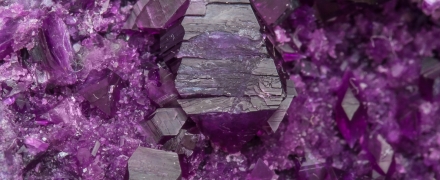open 10 am - 7 pm
laboratory is closed
Clinochlor

Continuing the theme of layered silicates (phyllosilicates) used as jewelry inserts, let's talk about clinochlore. Clinochlor is a magnesium aluminosilicate with an additional hydroxyl group. This mineral is soft (Mohs hardness 2-2.5), does not have an outstanding color (usually painted in grayish-green tones) and only its chrome variety has a lilac-pink color of a low degree of saturation and an alexandrite effect. The mineral is widely distributed, but the material suitable for processing as jewelry inserts is known only at the Korshunov iron ore deposit in the Irkutsk region. For the manufacture of cabochon inserts, a variety is used that has received the commercial name "serafinite". It is represented by kidney-shaped rosettes of clinochlore, in the context of which the mineral aggregate has a beautiful fir-tree pattern, sometimes compared to an angel's wing. And although the color of this stone does not differ in bright colors, the pattern, complemented by the play of reflective surfaces of the grains of the aggregate, attracts attention and pleases the eye with its “mysterious” depth. In view of the fact that clinochlore has a low hardness, it is used as a decorative collection material, in the manufacture of decorative plates, as well as cabochons for inserts, mainly in earrings and brooches. It is rare to find rings with seraphinite inserts, beads, and caskets made from plates of this ornamental stone.
В геммологической практике бывают весьма увлекательные случаи с диагностикой ювелирных вставок
Но помимо редкости цвета и высокой стоимости таких камней, многие розовые камни выделяются одной замечательной особенностью – они проявляют плеохроизм, то есть в зависимости от положения осмотра камня он может иметь дополнительные оттенки – оранжевый или пурпурный.
Currently, gemstones are produced by two fundamentally different technological methods - the High Pressure - High Temperature method (“HPHT”, High-pressure & High-temperature) and the Chemical Vapor Deposition (“CVD”, Chemical vapor deposition) method. The "HPHT" method is the most tested classical synthesis method, which can be used both carbon deposition on diamond from flux melts and catalytic reactions. In "CVD" synthesis, diamond growth occurs on a seed during carbon deposition mainly from a gaseous medium at relatively low temperatures and pressures.
Jewelry and precious stones are just such a category of goods, when buying which you need to pay attention to many criteria.
Sogdianite is a rather rare mineral and more often it can be found as a collection material (moreover, in systematic collections), and it is extremely rare in jewelry.






